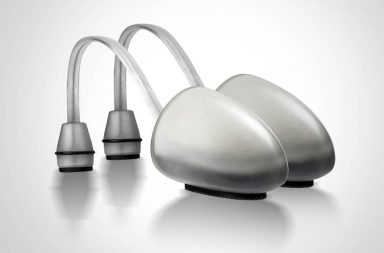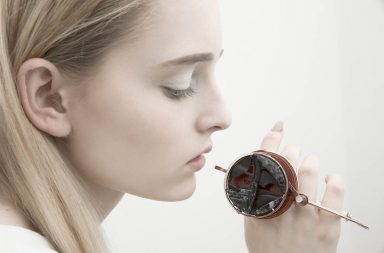We love Isabelle Fustinoni. The way she combines materials and techniques, her taste, which is marked by natural shapes and African motifs; we find her fascinating. Isabelle likes to work with ebony, with seeds and with stones, creating beautiful mini-sculptures that, once again, have shown us that jewelry is really art that you wear.

Isabelle, 52 and from Strasbourg, spent part of her life living in and working with artisanal techniques in Senegal, Tanzania and Kenya. She never makes two pieces that are the same and her maxim is to create pieces that can awaken emotions and tell stories.
She talked with us here at So Catchy! Where Fashion Begins recently and we’re sure you’ll enjoy.

SO CATCHY!: You originally studied Art, when did you decide that jewelry would be the field you specialized in?
ISABELLE FUSTINONI: When I entered the Ecole des Arts Décoratifs, I knew I wanted to create objects, but had not yet decided in which field. Then I discovered the goldsmiths’ workshop. I was immediately fascinated and felt strongly attracted to that universe: to learn how to master the tools and techniques, to transform materials in order to give life to my ideas, was for me like becoming an alchemist, a magician.
I also very much liked the idea of working on a reduced scale, on pieces requiring skill, accuracy, attention to minute detail, so that someone who is not familiar with that particular craft will be puzzled, will try and penetrate their secrets… and wonder. Moreover when you work on objects that are ‘mini-sculptures’ people will wear, you have to think hard on some important notions such as wearability, comfort and durability. What I’m interested in is how all these factors blend together. To create unique objects, arousing curiosity and wonder, telling everyone a story to their own fancy in which they will recognize themselves, that will belong to them and them only. This is how a jewel comes to life and becomes a personal, intimate object.

SC!: You are in love with Africa and its craftsmanship. When did you start travelling there?
IF: When I first travelled to Tanzania in 1993, I discovered various approaches to jewelcraft corresponding to various ethnical groups (Swahili, Bantu, Maasai…). But I was more particularly attracted to the island of Zanzibar, off the Tanzanian coast. In this extraordinary cultural melting pot, Africans, Persians, Arabs, Egyptians, Omanese, Indians and Europeans succeeded one another. Jewels and ornaments, enriched as they are with all these contributions, show a great diversity in techniques, styles and symbologies. Amongst other traditions, Zanzibar also inherited the crafts of filigree and embossing, particular to the Horn of Africa.
I wished to meet local artisans and work with them in their workshops. What I wanted was complete immersion in a universe culturally so different from mine, enlarging my field of creation, of abilities. To learn, to exchange, to share, to open new possibilities.
I then submitted my project : “Precious Encounters”, to the CEAAC (Centre Européen d’Actions Artistiques Contemporaines) in Strasbourg. They studied it and in 1994 awarded me a grant so that I could make it come true; I was able to go back to Zanzibar for 6 months. This was the first of a long series of new and wonderful experiences in East- and West-African workshops.
SC!: Why do you like African artisanry so much?
IF: I always felt fascinated and amazed by the inventiveness, the ingenuity, the technical skills displayed by African artisans, compared with the scarcity of materials or technical means at their disposal, as well as their ability to recycle often imported objects or materials through works in which only their own cultural identity would show in the end.
I love the infinite creative diversity displayed throughout Africa, ranging in its expressions from the rawest to the most refined.


SC!: What does this artisanry have that others don´t ?
IF: What you get extra with an African jewel is that it ‘tells you a story’! Unlike what happens in our Western world, each particular jewel conveys a huge amount of information. Whether through simple pieces or patiently elaborated materials, such jewels perpetuate traditions, tell stories, and arouse imagination. Far beyond the ornamental, an African jewel tells us a lot about the person wearing it; their ethnic group, religion, social rank, matrimonial status, age, etc…
Moreover, workshops are real places to live, exchange and share. You do work, but you also palaver, eat, sing, laugh… a wonderful human experience. Precious encounters!
SC”: What´s the most valuable lesson you learned from them?
IF: I learnt a great deal from them, but since I have to choose, I will only mention the lessons of simplicity and sincere humility all these artists taught me, ‘Ordinary’ artisans creating ‘Extraordinary’ objects.


SC!: Let’s talk about your work now. Tell us about your last collection, “Sombres et Lumiêres”.
IF: My last collection, “Sombre et Lumières” (Dark and Lights) was created at the request of Diane and Eric Lhoste to be exhibited in their gallery in Biarritz.
These pieces were inspired by ecclesiastical jewels, more precisely, episcopal rings for which I have a particular liking. I carved some very beautiful pieces of ebony of various textures that I had brought back from my travels in Africa. I also had a stock of various materials of all kinds and origins, and some transparent and frosted glass beads from ancient chandeliers. What I was tasked with doing was to enhance each of these materials, round and soft as they were, by uniting them to metal… Thus, finally illustrating what we all are: ‘Dark and Lights’.
SC!: What’s your favorite material to work with and why?
IF: All materials find favor in my eyes. I am curious about everything around me. I use many natural materials from my rambles and travels (seeds, stones, shells, etc…) but have also made frequent use of mechanical devices, materials out of the industrial world. I like to look further through things, to abstract them from their contexts, to obliterate their origins or primary functions, to magnify the simplest things to bring them to a state of extraordinary.
Moreover, some of my clients come to me asking for a jewel made of things they gathered during their lives and which remind them of a particular place, instant or person : we both join in the same process of making a jewel a very intimate object that tells us a story and is sometimes the keeper of our memories.
SC!: The best part of your work is… and the worst?
IF: What I like best in my work is when the idea in my mind becomes a reality and it works as I had imagined: perfect happiness!
On the contrary, when it doesn’t work and reality is not up to what I had in mind… how frustrating… it all must be done over again!

SC!: What are you doing right now? And what would you love to be doing in the near future?
IF: I am now at work on a more metallic and geometrical collection of new rings and brooches. I feel like creating rather cold, sober chrome metal shapes, combined with natural elements adding their delicate materials, their soft and wavy lines. Once again my concern is to play on contrasts and make various universes mingle, different as they are in shapes, origins and textures, so as to create poetical hybrids arousing curiosity in whoever discovers them. That they should not appear as evident, but objects for discovery…
In the future I would like to integrate bright colors to my work. Up to now, the colored elements present in my pieces are exclusively due to the materials’ rather neutral and soft natural hues. I still haven’t found a perfectly satisfactory idea, I’m working on it…

SC!: Which piece are you most proud of and why?
IF: I chose this brooch that belongs to a collection that is particularly dear to my heart. It is the fruit of a technique, silver filigree, I acquired in a traditional workshop in Senegal, combined with my taste for natural raw materials. It is a good representative of what I like to express in my creations: blendings of techniques and materials, different universes joining together, contrasted associations of the wild and the refined.
SC!: How would you define your work and what do you want to tell people with it?
IF: I should say my creations are the results of a blending of techniques and materials, an attempt to poetically unite the contemporary and the traditional.
I hope that whoever discovers my work will wonder about it and try to find what it is all about. That the objects won’t appear as evident, but as universes for exploration, guesses and discoveries. My intention is to attract people to my universe and stir up their curiosity, their imagination, giving rise to emotions. I am convinced that when we want to acquire a jewel it is not simply due to its decorative function. It must tell us a story in which we recognize ourselves and we feel must become our own; a jewel is an object linked to our most intimate universe.
SC!: What are some things you do, read, see, etc… that help you to design?
IF: As I said, I am full of curiosity towards everything around me, so that inspiration may arise out of anything, but most of the time out of the materials themselves. The desire to enhance them, to combine them; It is as if I were playing an assembly game. I assemble, disassemble, again and again till it appears as an evidence; the object is there, beautiful, just as I had imagined, just as I want it.

SC!: What are your favorite magazines about design, art, fashion….?
IF: I have no favorite magazine. I like magazines and art books from here and there, about today’s and yesterday’s design, architecture, fashion, jewels…etc. The Internet, too, is of endless resource to me for creations, new ideas, and information from all over the world, in every field.
SC!: A piece of jewelry you can’t stop wearing…?
IF: It is a silver ring that was given to me by a Senegalese friend of mine, a jewelry designer with whom I worked for a long time in Senegal as well as in France. He taught me a great deal. He is a fabulous craftsman, an outstanding master of the traditional silver- and goldsmith’s techniques in his country, which I learnt from him and sometimes use in my work.
It is a “Grigri” ring, somewhat of a fetish, a typical Senegalese jewel. It consists of a wide ring with a box fixed on the top, containing things I know nothing about but are supposed to protect me… I love it and wear it all the time!

SC!: Where can we buy your pieces? What’s the average price for one of your pieces?
IF: For the time being, some of my pieces can be seen at the Gallery Diane & Eric Lhoste in Biarritz, France. You can also see them on my Facebook page or on my web site and contact me through my website. Or you may come and see me directly at my workshop in Strasbourg!
Prices vary according to the nature of the objects concerned (rings, brooches, necklaces) and the materials used. They are all unique pieces, never duplicated. I should say the average price for a ring would be between 200€ and 400€, for a brooch, between 250€ and 500€ and for a necklace between 300€ and 700€ (once more these are only indicative prices, subject to variations).
SC!: A jewelry designer or label you are in love with…?
IF: I have a particular liking for creators from the Far East, and especially for the works of the Japanese and the Koreans. Their creations are always refined, subtle, full of a poetry that goes directly to my heart.
But if I have to choose only one, I will choose Philip Sajet, a fabulous artist in jewelry. I like the delicate extravagance and the strength of its forms and materials. (Check out So Catchy!’s interview with Philip here). I’m in love with his work and each of his pieces is to me a wonder.
All images courtesy of Isabelle Fustinoni
Translation and Layout by Michael Padilla




